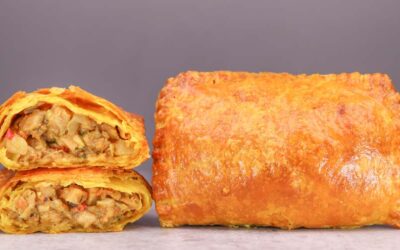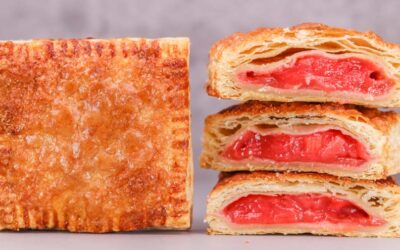This leavened laminated pastry recipe has been working surprisingly well and it is quite versatile. First, we made kouign-amann then we made Danish pastry knots, and even pain aux raisins. It’s just as good as the regular unleavened rough puff pastry that I am so fond of. They both have different uses which can sometimes overlap, but not all pastries can be made with the unleavened version. If you are looking for something super light like croissant dough, then this is the one for you.
The recipe formula is slightly different this time. I lowered the hydration a bit to make it even easier to handle and to eliminate the second fold. The rest is pretty much the same. In fact, this recipe is the easiest of all the laminated pastry recipes we’ve made so far. Final shaping is nothing more than dividing the pastry and folding some chocolate into it.
The result is light and buttery, not very sweet, but with a nice little hint of chocolate. One important thing to note is the choice of chocolate. It must be milk chocolate that is on the sweet side. And that is for two reasons – First, dark chocolate would melt and leak out of the pastry and ruin your day. Second, the sugar content comes in handy to balance the flavour as the pastry itself contains very little sugar.
This recipe makes 9 small pastries. To make more simply multiply all the ingredients.
Watch the video down below for detailed instructions.
Ingredients
For the dough –
250g (8.8oz) white bread flour
3g (0.1oz) instant dry yeast or 3.6g (0.13oz) active dry yeast or 9g (0.32oz) fresh yeast
4g (0.14oz) salt
20g (0.7oz) sugar
20g (0.7oz) melted butter
130g (4.6oz) water
2 x 100g (2 x 3.5oz) frozen butter for the layers
1 egg for glazing before baking
120g (4.25oz) milk chocolate cut into 18 thin batons.
*To learn more about no-knead bread dough temperature control click here.
The flour I use has a protein content of 13%. If your flour is weaker, then you may need to lower the hydration.
If you are using active dry yeast, then you may need to let it sit in the water for 10 minutes before adding the other ingredients or else it could take a lot longer to raise the dough.
Method
- Make the dough. Combine the water, yeast, salt, sugar, and melted butter. Mix well to dissolve the salt and sugar, and to hydrate the yeast. Add the flour and mix to a dough. *Desired dough temperature around 25C (77F).
- Cover and ferment for 30 minutes.
- Fold.
- Ferment for 30 minutes.
- Roll the dough out to a rectangle. Grate one of the butter pieces evenly all over the surface. Fold the dough into three layers. Roll it out again and fold into three once more.
- Cover and refrigerate for 30 minutes.
- Roll the dough out to a rectangle once again. Grate the second piece of butter and repeat the same folds as previously.
- Cover and refrigerate for at least 1 hour. I left mine overnight.
- Shape the pastries. Roll the pastry to slightly larger than 30cm x 21cm (12in x 9in). Trim the edges and cut into 9 equal pieces measuring 10cm x 7cm (4in x 3in). Roll the chocolate pieces into the pastry.
- Cover and proof for 2.5 – 3 hours. If you only chilled the pastry for 1 hour, then the final proof may take 1.5 – 2 hours.
- Brush with egg and bake at 170C (340F) fan on for 25 minutes.
Keep in mind that the conditions in each kitchen are different, so fermentation times may vary for you. It is up to the baker to control the bread and react accordingly.
Your oven may be different too, so your baking time may vary.



